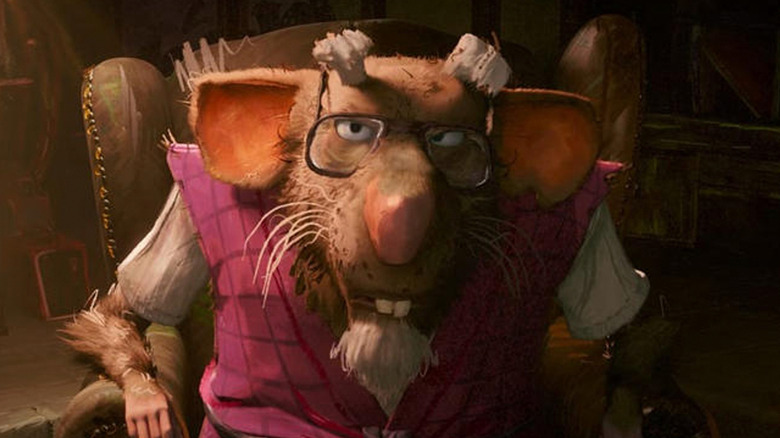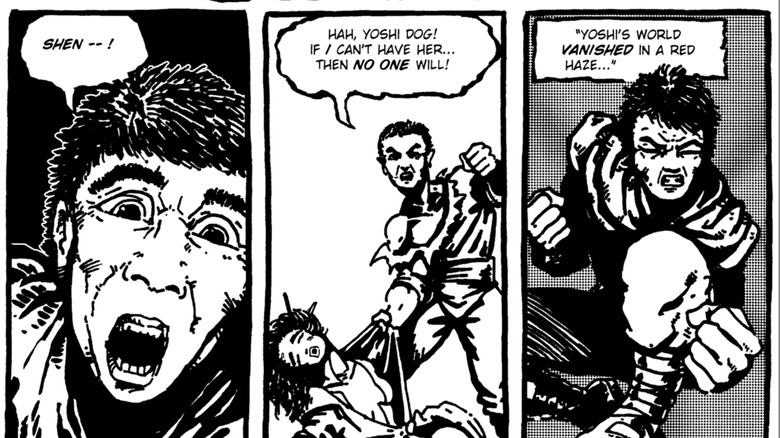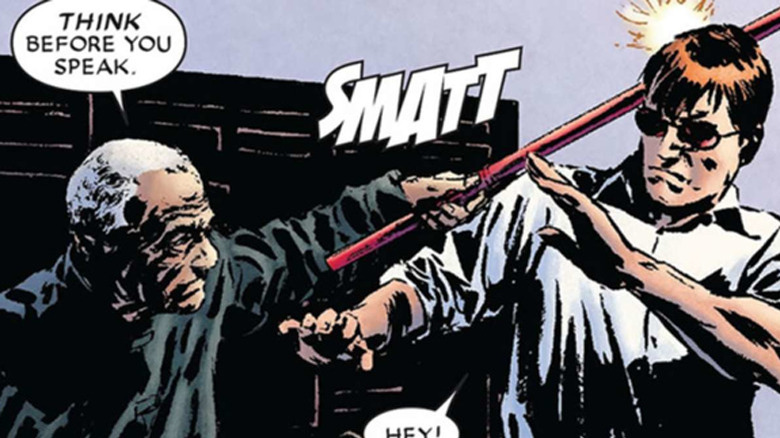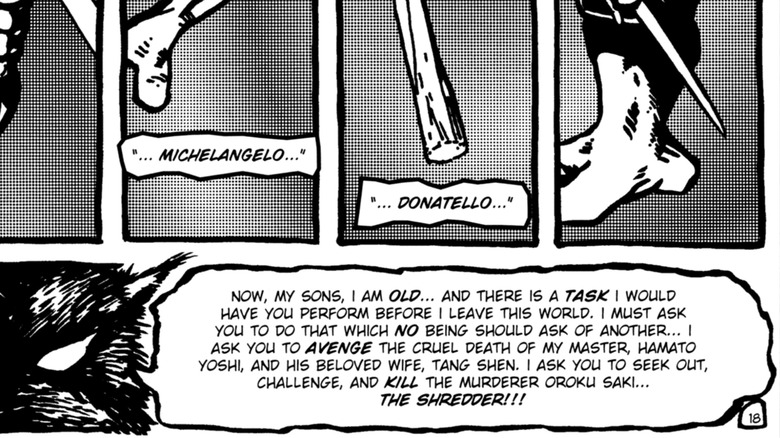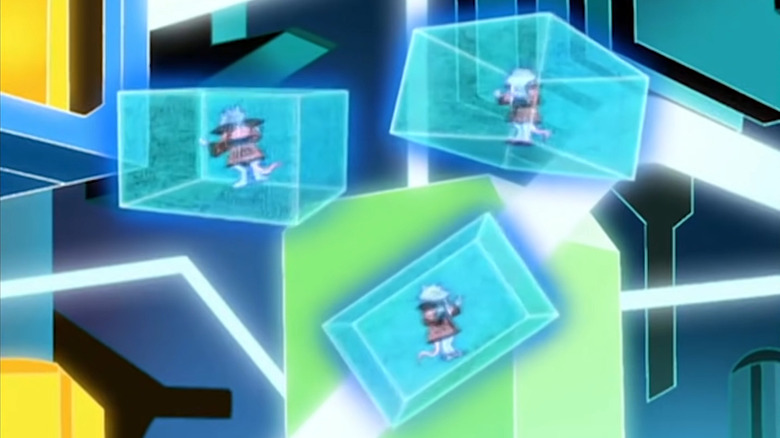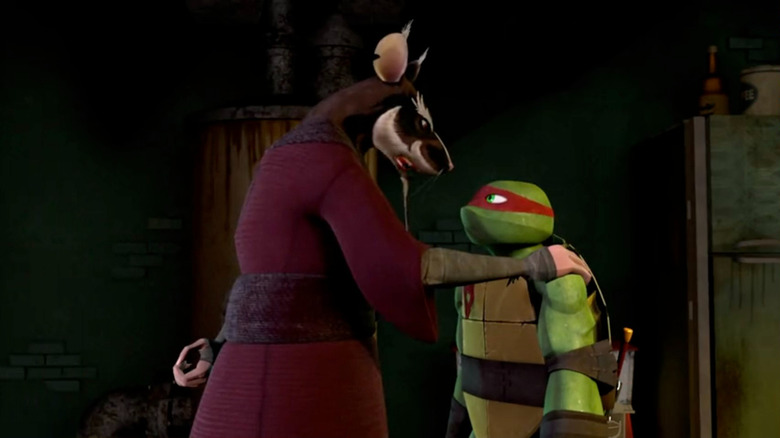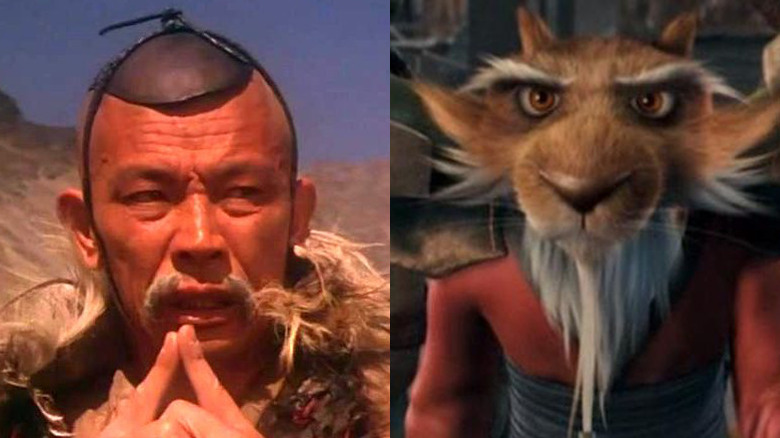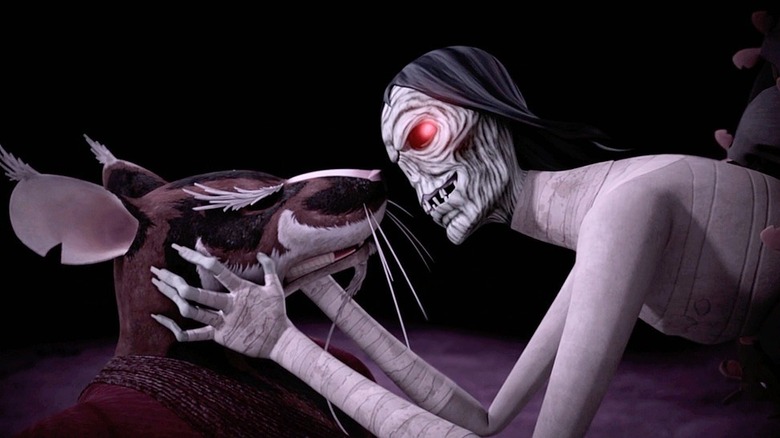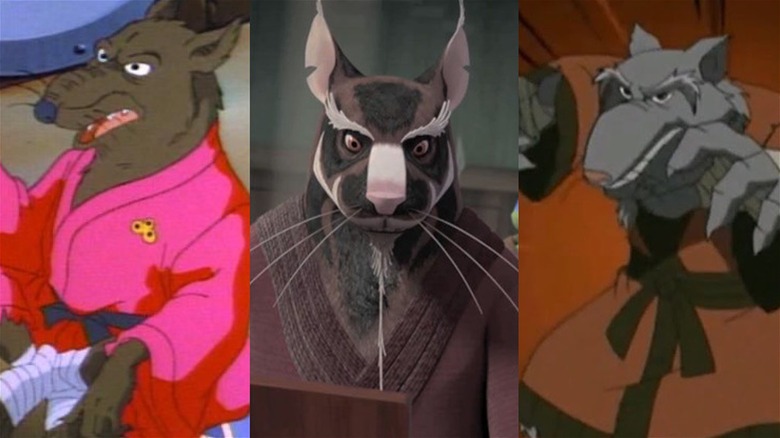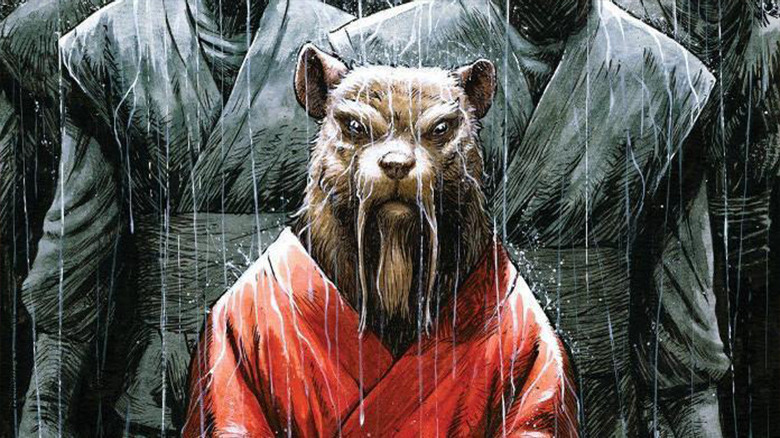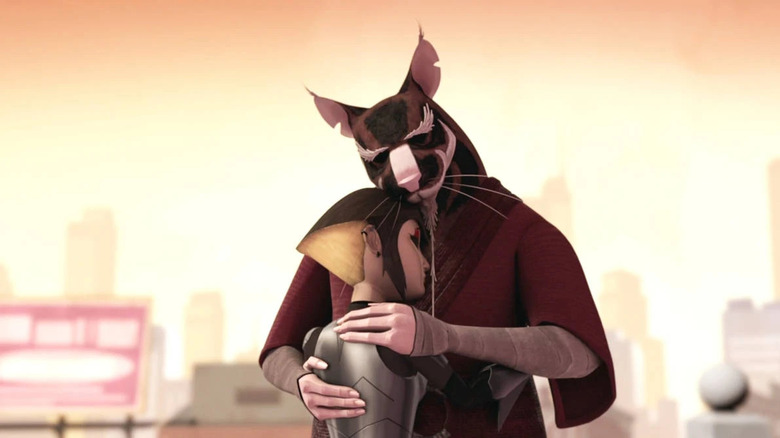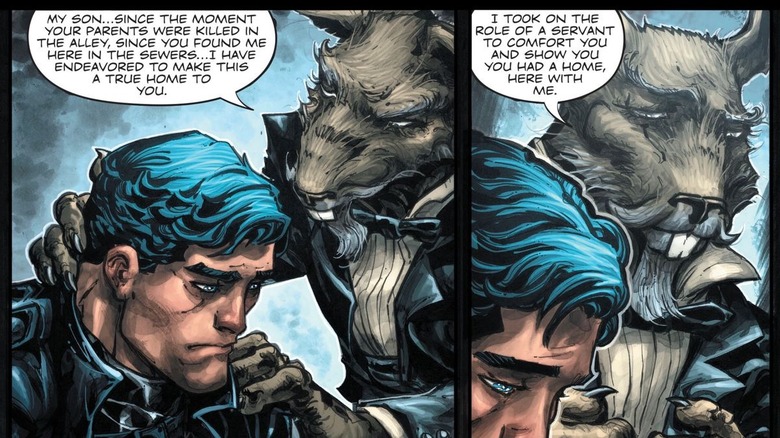The Untold Truth Of TMNT's Master Splinter
When it comes to the ever-evolving and frequently bonkers world of "Teenage Mutant Ninja Turtles," one of the few constants has always been Master Splinter. First introduced in Kevin Eastman and Peter Laird's original Mirage Studios comic book run, Splinter has served as the Turtles' mentor and adoptive father.
Depending on the version of the story presented, Splinter is either martial arts master Hamato Yoshi's pet rat or a mutated version of Yoshi himself. While his backstory, along with his design, has always been in flux, his skills and core character traits never have. Possessing both incredible wisdom and top-tier fighting prowess, and despite his soft-spoken nature, Splinter never fears battling alongside his sons. However, there are a few facts that even the most hardcore Ninja Turtle fans might not be aware of. So pick up the cheese phone and clear your mind of anger, because this is the untold truth of TMNT's Master Splinter.
His backstory was originally much darker
Master Splinter's backstory changes quite a bit based on what incarnation you happen to be digesting, especially if it's intended for younger audiences. In the 1980s and 2012 cartoons, for example, we are told that martial arts master Hamato Yoshi is simply mutated by the Mutagen along with the four turtles.
However, in the original comic book run, things were far different and far darker than anything that'd be allowed in a Saturday morning cartoon. The circumstances of Splinter being Hamato Yoshi's pet remain still the same, but Yoshi's characterization differs tremendously. Here, he and his rival, a man named Oroku Nagi compete for the affections of a woman named Tang Shen. Shen ended up choosing Yoshi, which sent Nagi into a blind rage, and he mercilessly beat her. This, in turn, caused Yoshi to snap and beat Nagi to death with his bare hands!
His death not only prompts Yoshi and Shen to leave Japan but it causes Oroku Saki, Nagi's brother, to seek revenge. After extensive training, Saki becomes known as The Shredder, leader of the Foot Clan, and tracks the couple down in New York City. He brutally murders them both, leaving a pre-mutation Splinter without a caretaker and forcing him to scurry through the streets of the city. While the first theatrical film was partially accurate to this version, no subsequent adaptation ever dared to adapt this darker backstory beat-for-beat.
He was inspired by Marvel Comics' Daredevil
The origins of the "Teenage Mutant Ninja Turtles" are just about as humble as a comic book can be, with two buddies joking around while drawing. Goofing off in between work on one of their indie comics, a young Kevin Eastman and Peter Laird began doodling turtles with ninja weapons. The duo started one-upping each other with increasingly absurd sketches until eventually both of them were in love with the utterly gonzo idea.
As they fleshed out the lore of these Ninja Turtles, they imbued the story with things they loved, including Frank Miller's "Daredevil" comic book run. This is very evident when you realize that the Foot Clan is a less-than-subtle parody of the Hand, the ninjas that Matt Murdoch is always fighting. More importantly, though, Splinter's name pays direct homage to Daredevil's blind mentor, a man by the name of Stick. These references, alongside the intentionally overly gritty tone presented in the early comic issues, result in some definite laughs if you're in on the joke.
Splinter lives up to his influence by also wielding a simple stick as a weapon, as opposed to more contemporary ninja weaponry. It's references like this that make the origins of the franchise so fascinating and, as noted, a true hodge-podge of everything that Eastman and Laird loved.
He wasn't always so peaceful
Most iterations of Splinter, whether animated or live-action, tend to feature some key traits that have remained fairly uniform across his various incarnations. This includes his dry sense of humor and love for his sons but especially his peaceful nature. He never rushes to violence. If a more peaceful and harmonious solution exists, Splinter more often than not walks that path. Not to say Splinter can't fight, because he most definitely can, having taken down some major threats on his own many times.
However, anyone who has read the original Mirage Comics runs knows that Splinter wasn't always so zen. Following the death of his master, Hamato Yoshi, at the hands of the Shredder, Splinter swore revenge on the mental miscreant. So, he spent the next several years training his sons — Leonardo, Donatello, Raphael, and Michaelangelo -– in the art of ninja so they could kill the Shredder!
This is a far cry from the more cautious and peaceful mentor depicted in all subsequent adaptations. The Turtles do indeed get revenge for their master, even going as far as to stab Shredder to death before he gets blown up. Never forget that, at one point, Master Splinter was just as ruthless as the threats that his sons constantly contend with.
He was trapped in the internet for a while
The 2003 "Teenage Mutant Ninja Turtles" cartoon that aired on Fox's 4Kids TV block stands as a definitive interpretation for many fans. Before the 2012 CGI version, it felt like a proper adaptation of the original comic books, albeit sanitized the appropriate amount for Saturday mornings.
However, not every creative decision made during this series was a good one, with the series taking some truly bizarre left turns. One of the biggest happened toward the end of the series due to its sixth and seventh seasons, known respectively as "Fast Forward" and "Back to the Sewer." To make a long story short, the Turtles found themselves trapped in the far future for a while, desperate for a way back to their time. They eventually succeed but thanks to a technical mishap, Splinter ended up trapped in the internet. This meant that the Turtles needed to travel the web and collect Splinter files in order to restore their master. Even by "TMNT" standards it's a pretty ridiculous plot development that fans don't often recall with much fondness.
He can be a very stern parent
For better, or for worse in some cases, our parents make up a huge part of who we are as people. However, few of us are Ninjutsu-practicing turtles raised in the sewers by a talking rat after exposure to mutagen ooze. The Turtles and their relationship with Splinter is one of the most endearing parts of any version of their frequently retold tale. Whether it's printed, animated, or live-action, one element never changes: Splinter's love for his four sons. Whenever one of the Turtles experiences a personal issue or emotional conflict, Splinter is usually right there and ready to share his wisdom with them.
However, much like any parent, Splinter knows when to lay down the law with his kids, even grounding or punishing them on more than one occasion. A prime example occurs in "Teenage Mutant Ninja Turtles II: The Secret of the Ooze," where he makes the Turtles do flips as penance for being spotted by humans. This same treatment even carried over to the 2014 live-action movie, as Splinter forced them into the Hashi, a series of torturous strength-building exercises, for several hours. Despite his harsh punishments, however, Splinter rates as a stellar parent, even if he needs to shoot his boys a death glare every so often.
He's been voiced by Mako
Master Splinter has seen himself voiced by a slew of voice talent across his various incarnations, with each one standing out in its own way. In the 1980s cartoon series, the radical rat was voiced by Peter Renaday, providing a very wise albeit cheesy-sounding interpretation. In the 4Kids series, he'd receive a more aged voice in the form of Darren Dunstan, also known as Maximillion Pegasus from the English dub of "Yu-Gi-Oh!"
However, by far the most legendary actor to lend his voice to Master Splinter has been none other than Makoto Iwamatsu, aka Mako. Even if you've never heard his name, there's a good chance that you and even your parents have been entertained by his talents for years. Not only did he play Akiro the Wizard in "Conan the Barbarian," he's lent his voice to several animated classics. These include his roles as Uncle Iroh in "Avatar the Last Airbender" and Aku in "Samurai Jack."
Most relevant here, though, is his take on Splinter from when he played the character in 2007's "TMNT," released by Warner Brothers and Imagi Animation Studios. Much like with all his characters, Mako made this version of Splinter his own, adding subtle little nuances to enhance the character. This includes happily humming a Japanese song while greeting the four Turtles in the morning, something Splinter would surely do.
His feud with The Rat King
The 2012 computer-generated version of "Teenage Mutant Ninja Turtles" defied all expectations when it first dropped on Nickelodeon. What many thought would be a gentler interpretation of the iconic characters turned out to be far grittier and more inventive than anyone expected.
Not only did the show boast both epic action and emotional moments, it also delivered the creeps. Case in point: the 2012 series' interpretation of the Rat King and his frequently disturbing run-ins with Master Splinter. Aside from the Shredder, the Rat King serves as Splinter's main foil, despite only having a handful of onscreen appearances. Given the Rat King's ability to control rats like zombies, this makes Splinter a prime target for his grotesque machinations. At one point, the Rat King even forces Splinter to fight the Turtles while under his sinister control.
It's clear that Splinter legitimately fears the Rat King or — more so — what he could be forced to do while under his influence. Even after he sends the Rat King falling to his doom, a vision of him still haunts Splinter later on in the series. It's a tremendously presented hero-villain dynamic and one that injects the show with a welcome dose of nightmare fuel.
His design has gone through many changes
Much like any long-running fictional character, Master Splinter has gone through his fair share of design changes as the years roll by. In the beginning, Splinter's design was just as gritty as the comic he was introduced in, with brown fur and sporting tattered rags in place of regular clothing. Appropriately blank, rat-like eyes — that were more intimidating than any subsequent version — completed the look.
This design was mostly mentioned in the original live-action movies and cartoons, with the only real change in the latter coming in the form of a red Japanese robe. The 4Kids series changed things up a bit, ditching the brown fur in favor of a more elderly gray and adding a long goatee. Following this, the brown hair made a comeback in both the 2006 animated movie and the 2012 Nickelodeon series, along with the goatee. This version also kept Splinter in a red robe, very much in the same vein as the 80s cartoon.
Most recently, Splinter underwent two major visual overhauls — in the "Rise of the Teenage Mutant Ninja Turtles" series and the theatrical "Mutant Mayhem" film. "Rise" saw Splinter shrink in size, as well as return to his gray hair but with the addition of white hair and a beard. In "Mutant Mayhem," Splinter looks far more like a dorky dad, complete with glasses and buck teeth.
He's led the Foot Clan
IDW Comics' ongoing "Teenage Mutant Ninja Turtles" series definitely made an impact on fans upon its debut in 2011. If you've never taken a dip into the series, you really should as it boasts some truly stellar writing, especially in regards to its characters.
Comic books, for the most part, aren't subject to the exact same scrutiny as movies and cartoons, giving them a touch more freedom. The result? A series that takes what you know about the Turtles, as well as their lore, and steers them in some truly unique directions. The new wrinkles include a change to Splinter's backstory, with him and Oroku Saki training side-by-side to be Foot Clan members in the past.
This, of course, didn't pan out and Splinter, formally Hamato Yoshi in a past life, decried the Foot Clan's cruelty and violence. This led to intense animosity between Splinter and Shredder, like most versions of "TMNT," wherein they'd battle for control of the Foot Clan in the modern day. In a shocking turn of events, Splinter won and ended up assuming full control of the Foot Clan, utterly altering its ethical alignment. It's an intriguing twist on things and a prime example of just how unexpected the IDW comic book series can be.
His complicated relationship with his daughter, Karai
Nickelodeon's CGI version of the Turtles helped refurbish quite a few side characters, giving many of them a much-needed update. From April to Casey Jones to the Rat King to Slash, classic characters were given brand-new designs and entirely different personalities.
Nowhere is this more evident than with Karai, a ruthless Foot Clan member who also happens to be Splinter's daughter. In the aftermath of a past fight with Oroku Saki, aka the Shredder, Splinter assumed that both his wife, Tang Shen, and his daughter, Miwa, were dead. This proves to only be half true, as it's revealed that Shredder raised Miwa as his own and to believe that Splinter killed her mother.
This means that Karai has nothing in her heart for Splinter apart from desires of revenge, much to the heartbreak of her true father. Along the way, however, Karai eventually accepts the truth and finally acknowledges Splinter as her true father. Sadly, Splinter meets his end ahead of the series finale but not before receiving some closure with Karai. Much like with many of the ideas introduced in the IDW comic book series, this was a welcome change that actually added a lot to both characters.
He once fused with Batman's butler Alfred
This really is a funny world we live in, with multiple crossovers between Batman and the Teenage Mutant Ninja Turtles, including a stellar animated movie. It's a concept that frankly sounds ridiculous on paper, but, in fairness, both ideas consistently revel in their own absurdity ... to begin with anyway.
The third comic crossover, "Batman/Teenage Mutant Ninja Turtles III," aka "Crisis in a Half Shell," served as the big blow-off for their team-ups. Due to the machinations of Krang, both the DC Universe and the Ninja Turtles universes have been mashed together. This results in fusions of their respective villains, like the Shredder and Joker, a figure known as the Laughing Man. However, one of the biggest shifts reveals that Batman and the Turtles were raised together by a fusion of Alfred and Master Splinter. Given how both serve as mentor figures and often look for more levelheaded solutions, this fusion makes perfect sense. Additionally, it is kind of hilarious seeing Batman referring to this version of Splinter as his father and viewing the Turtles as his siblings.
